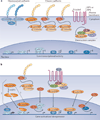Beyond β-catenin: prospects for a larger catenin network in the nucleus
- PMID: 26580716
- PMCID: PMC4845654
- DOI: 10.1038/nrm.2015.3
Beyond β-catenin: prospects for a larger catenin network in the nucleus
Abstract
β-catenin is widely regarded as the primary transducer of canonical WNT signals to the nucleus. In most vertebrates, there are eight additional catenins that are structurally related to β-catenin, and three α-catenin genes encoding actin-binding proteins that are structurally related to vinculin. Although these catenins were initially identified in association with cadherins at cell-cell junctions, more recent evidence suggests that the majority of catenins also localize to the nucleus and regulate gene expression. Moreover, the number of catenins reported to be responsive to canonical WNT signals is increasing. Here, we posit that multiple catenins form a functional network in the nucleus, possibly engaging in conserved protein-protein interactions that are currently better characterized in the context of actin-based cell junctions.
Figures





References
Publication types
MeSH terms
Substances
Grants and funding
LinkOut - more resources
Full Text Sources
Other Literature Sources

